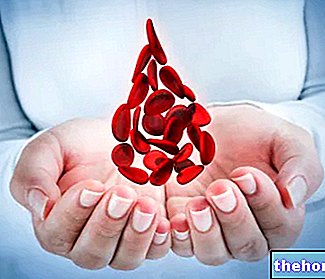
From a clinical point of view and on the basis of the rate of progression, leukemia is divided into acute (severe and sudden manifestation) or chronic (slowly worsening over time).
Another important classification depends on the cells from which the neoplasm originates: we speak of lymphoid (or lymphocytic, lymphoblastic, lymphatic) leukemia, when the tumor affects the intermediate precursors of T or B lymphocytes and myeloid leukemia (or myeloblastic, myelocytic, granulocytes), when, on the other hand, the degeneration concerns the common progenitor of granulocytes, monocytes, erythrocytes and platelets.
Based on these considerations, we will have four common types of leukemia: chronic myeloid leukemia (CML) and acute myeloid leukemia (AML); chronic lymphocytic leukemia (CLL, also called lymphocytic) and acute lymphocytic leukemia (ALL, also called lymphoblastic).
, toxic substances such as benzene derivatives, infectious agents ...). The uncontrolled proliferation of leukemic cells is the result of an "anomaly in the DNA, which - as indeed in other types of neoplasia - determines an" alteration of the mechanisms of regulation and control of cell growth and differentiation. These processes are regulated by specific genes which, if damaged, can determine the transformation of a cell from normal to neoplastic, according to events that are only partially known.
Although the causes are not yet fully understood, some myelotoxic agents (benzene, alkylating agents and ionizing radiation) that can promote leukemogenesis have been identified with certainty.
The main risk factors, which can facilitate the onset of leukemia, are:
- Exposure to high doses of ionizing radiation, which can occur due to:
- Radiotherapy: the incidence is very high in subjects treated with radiotherapy for other neoplasms, in which case the blood cancers are defined secondary.
- Atomic accidents: to remember is the tragic toll between the survivors of the atomic explosions in Hiroshima and Nagasaki, exposed to high doses of radiation and severely affected by leukemia.
- Occupational exposure: it is possible that there is an "association between leukemia and prolonged exposure to radiation, to certain chemicals in the workplace and home, or to low frequency electromagnetic fields;" however, there is still no definitive evidence that demonstrates its close correlation.
- Benzene: used in the chemical industry, present in oil and gasoline. Its prolonged inhalation over time is initially associated with haematological dyscrasia (alteration of the relationships of the elements that make up the blood or other organic liquids), which can degenerate into leukemia. To exert a mutagenic and carcinogenic action, benzene must undergo oxidative conversion and transform into reactive intermediates that react covalently with the DNA, causing an interference with the replicative and repair processes of the nucleic acid.
- The intake of antiblastics, type II topoisomerase inhibitors and some chemotherapy drugs may increase the risk of secondary leukemia (especially in combination with radiotherapy). The drugs that induce greater susceptibility are alkylating agents (chlorambucil, nitrosoureas, cyclophosphamide).
- Smoking can contribute to the onset of some forms of leukemia (1/4 of all acute myeloid leukemias occur among smokers), due to the presence of some substances contained in the cigarette, such as benzopyrene, toxic aldehydes and certain heavy metals (example : cadmium and lead).
- Some inherited diseases - such as Down syndrome or chromosomal instability syndromes - are linked to a 10-20 times higher risk of developing leukemia in the first ten years of life. In some of these diseases, the genetic mutation directly involves particular proteins involved in DNA repair processes. The risk of developing leukemia is therefore correlated to a lower cellular efficiency in the protection mechanisms in case of genetic alterations.
- Myelodysplasia (preleukemic pathology) and other predisposing blood diseases: make them more susceptible to the onset of acute myeloid leukemia.
- Human T lymphocyte virus type 1 (HTLV-1): are a class of oncogenic retroviruses (classified as oncoviruses), also referred to as human T-cell leukemia virus (Human T-cell Leukemia Virus), able to cause, in rare cases, leukemias and lymphomas in adults, and indirectly promote cell proliferation: the virus replicates slowly and remains latent for a long time in infected cells, mainly T lymphocytes. -1 is particularly implicated in chronic lymphoblastic leukemia (CLL).
- Family transmission: Only in rare cases does a patient with leukemia (chronic lymphatic in particular) have a parent, sibling or child affected by the same disease.
Exposure to one or more risk factors potentially implicated in leukemogenesis does not necessarily cause the onset of the disease. Furthermore, it is essential to remember that specific chromosomal alterations occur in the pathogenesis of the different types of leukemia, which allow to characterize the different neoplastic forms, such as the t (9; 22) translocation, with formation of the Philadelphia chromosome, in chronic myeloid leukemia. or trisomy of chromosome 12, common in patients with chronic lymphocytic leukemia. During diagnosis, the identification of specific aberrations affecting genes and chromosomes, by means of conventional cytogenetic techniques, in situ hybridization or molecular biology, makes it possible to identify the leukemia subtype and guide towards the therapeutic choice.
The disorders and symptoms of leukemia can vary in each patient, based on the type and quantity of cancer cells, and the severity of the disease. In some cases, in the initial stages the symptoms may be nonspecific and could be caused by other concomitant diseases.
Due to the proliferative advantage of leukemic cells, a "clonal expansion takes place which occupies a large part of the bone marrow and flows into the bloodstream. The invasive character of neoplastic clones also allows their spread to the lymphatic glands or other organs (example: spleen ) and can cause swelling or pain in various parts of the body.
Chronic leukemia patients may be asymptomatic and doctors can detect clinical signs during a routine blood test, while people with an acute form of the disease often undergo medical examination because of a sensation. general malaise.
Therefore, the general symptoms that can develop include:
- Fatigue and general malaise (asthenia), caused by reduced production of red blood cells;
- Vague abdominal discomfort, with loss of appetite and weight;
- Fever, due to the disease itself or to a concomitant infection (favored by the decrease in white blood cells by the bone marrow);
- Joint or muscle pain (in the case of a large tumor mass). In addition, a characteristic bone pain may occur due to the compression exerted by the expanding bone marrow;
- Excessive sweats, especially at night;
- Dyspnea (from lack of red blood cells), palpitations (from anemia).
Symptoms caused by blast infiltration in the bone marrow:
- Tendency to bruise or bleed (due to a decrease in the production of platelets, the elements in the blood responsible for clotting). Generally, blood loss is mild and typically occurs in the skin and mucous membranes, with bleeding from the gums, nose or due to the presence of blood in the stool or urine;
- Increased susceptibility to infections, usually caused by a decrease in the production of functioning white blood cells. Infections can affect any organ or system and are accompanied by headache, low-grade fever and skin rashes;
- Anemia and related symptoms such as weakness, easy fatigue and skin paleness.
Symptoms of leukemia caused by infiltration into other organs and / or tissues:
- Lymphadenopathy (swelling of the lymph nodes) especially latero-cervical, axillary, inguinal;
- Pain in the left side (under the costal arch) due to enlargement of the spleen (splenomegaly);
- Possible enlargement of the liver;
- Infiltration of the central nervous system (rare): leukemia cells can invade the brain, spinal cord or meninges. If this occurs, the patient can observe:
- Headache, whether or not associated with nausea and vomiting;
- Changes in the perception of sensation, such as numbness or tingling in various parts of the body
- Paralysis of the cranial nerves, with visual disturbances, drooping of the eyelid, deviation of the corner of the mouth.
In advanced stages, accentuation of the above symptoms may occur and the clinical manifestations of leukemia may include:
- Sudden fever rises;
- Altered state of consciousness;
- Convulsions;
- Inability to speak or to move the limbs.
If symptoms such as high fever, sudden bleeding, or seizures occur without an apparent cause, emergency treatment for acute leukemia is essential.
If there are signs of relapse, such as an "infection or" haemorrhage, in the remission phase (attenuation or disappearance of the symptoms of a disease), it is necessary to undergo a medical check-up.
Other articles on "Leukemia - Causes, Symptoms, Epidemiology"
- Leukemia
- Leukemia: Diagnosis
- Leukemia: Cure and Treatment
- Leukemia - Stem Cell Transplant and Bone Marrow Transplant
- Therapies for the various types of leukemia
- Side Effects of Leukemia Treatments




























